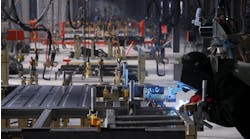History is the greatest teacher: How past disruption can help build more resilient supply chains
There seems to be no end in sight for global supply chain disruption. The good news is that, while supply chains are under attack on a variety of fronts, technology innovation can support modernization efforts that lead to more agile and resilient supply chains in the face of these challenges.
Let’s examine how leveraging data gathered from past disruptions can help organizations strategically modernize their supply chains to get ahead of such disruptions in the future. In the process, we’ll see how modern technologies for intelligent digitization and end-to-end visibility can help companies gain valuable insight from data at every point in the supply chain—and how we can leverage that insight for better strategies and investments moving forward.
Lessons for resilience within supply chain disruptions
Today’s supply chain challenges arise from a staggering and unprecedented combination of adverse factors; supply constraints, labor shortages and costs, unprecedented supply and demand fluctuations, inflation, and logistical complexities have all conspired to create historic disruptions, economic volatility and lost value for the enterprise.
In what amounts to billions of dollars for companies, the McKinsey Global Institute ascribes a 4.5% loss in profitability directly to supply chain inefficiencies. All the while, customers and partners are noticing and increasingly demanding supply chain transparency tailored to their business needs. Customers have aggressive expectations around timely delivery and improved sustainability as they struggle to navigate their own business risks.
The more we can learn from the context and causes around our current supply chain hurdles, the more we can leverage these learnings for targeted modernization efforts that support a more resilient and proactive operation. This is vitally important as supply chain innovation and enterprise investment continue to shoot up the list of enterprise IT priorities.
The critical question is how best to apply the right investments for maximum efficiency and value that extend across an increasingly complex ecosystem of suppliers, inventory, assets, logistics and customers. It’s this very complexity that too often leads to unacceptable waste from spoiled or expired products, misplaced shipments, unplanned delays and more.
The common factor underpinning these failures is the inability to act quickly to unforeseen changes because of a lack of real-time visibility into the end-to-end supply chain. Unfortunately, too many organizations remain poorly positioned to gain such visibility—hobbled by a myriad of systems, siloed data and manual processes that are slow, error-prone and difficult to automate or scale.
Digital intelligence for “all the time” visibility & control
As we clarify root causes and the need for more visibility and control in supply chains, several key attributes come into focus as necessary elements for any successful strategy. To begin with, there’s an overarching need to break the status quo from “point in time” supply chain planning to “all the time” supply chain operations. Intelligent digitization and collaboration across partners sharing data and problem-solving within the broader ecosystem can help achieve this.
To foster more resiliency, transparency and the ability to act quickly and collaboratively, it's essential to embrace real-time platforms to automate supply chain operations—to provide the visibility and intelligence, in the moment, to manage volatility and risk. Such visibility must be comprehensive, encompassing all sources regardless of where the data comes from, or where it resides in edge nodes, data centers, IoT sensors, environmental contexts, enterprise applications, logistics systems, vehicles, locations or other elements of the extended value chain.
This level of transparency helps unlock insights into demand and supply volatility, so organizations can be ready to quickly and strategically respond. Ideally, the levels of insight and control should extend to the point where organizations can preemptively act not just in real-time to risk, but can actually anticipate ahead of time to proactively address potential issues and keep them from manifesting in the first place.
Powerful gains in efficiency and value
With data-intensive digital-twin modeling of supply chains, companies can reach these levels of operation—finding themselves better able to anticipate risks, preventively resolve them and build resilience. And organizations that succeed in implementing such capabilities reap tremendous value.
To begin with, there’s an overall improvement in risk management, thanks to live IoT data and other information sources that can help highlight trouble spots—areas where processes or component availability may conflict with capacity and need. It’s also much easier to understand the downstream impacts of anomalies or potential bottlenecks. The use of digital-twin technology can make predictions before excursions, modeling likely effects of all courses of action in a safe, virtual environment before implementing changes.
Intelligent digitization systems can capture all connections and asset dependencies to understand the impact on the customer experience, network flows, chain of custody, compliance and more. This makes it easier to target and eliminate overstocks, shortages, excessive cycle times and other inefficiencies. On an even more granular level, supply chain managers can see in-transit variances to monitor patterns for choke points, dwell times, detentions, expedites and similar metrics. They can precisely analyze the affect of order promises, allocations, expedited orders, scheduling and more.
These combined benefits help optimize supply chains with enhanced traceability, better alignment of resources with projects, reduced material losses, expedited tasks and increased process efficiencies. Throughout, monitoring of capital assets is simplified—and tracking of reusable assets is easier as they move within facilities, into the field, back to customers and across geographies.
Conclusion
Today’s supply chain challenges are too steep and numerous for anything short of aggressive transformation in modern supply chains. To meet these tremendous challenges, there is no substitute for intelligent digitization to deliver enhanced levels of real-time visibility. This visibility makes all the difference in helping organizations take a more proactive and even preventive posture of resilience in the face of even the worst supply chain disruptions.
With the collection of timely and relevant data, organizations are empowered to change their packouts, identify new modes of transport and make other step-changes that can deliver profitability and new value to the bottom line. Businesses that will succeed in the new era of supply chain challenges will not just keep pace with disruptions, but find ways to leapfrog competitors and develop new sources of value.
By Mahesh Veerina, CEO of ParkourSC



